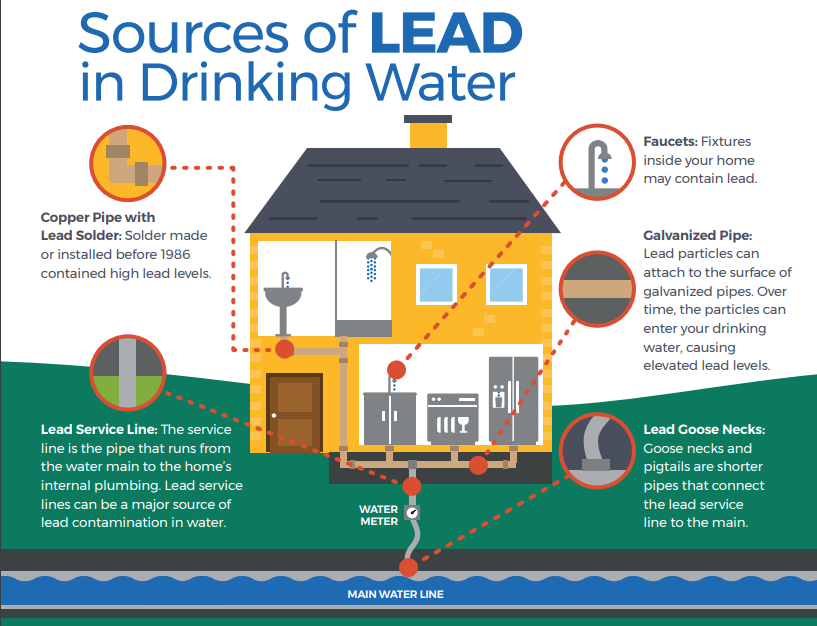Sunset Valley, TX
Home MenuLead Service Line Inventory
In order to better protect customers from possible sources of lead, the Environmental Protection Agency and Texas Commission on Environmental Quality have required each public water system to create an inventory of all service lines within the City. Service lines are what connects individual homes and businesses to the water main. The ownership of service lines are split between the City and the customer. The City owns and maintains the portion from the main to the meter. The customer is responsible for everything beyond the meter and within the home.
The City has completed it's inventory of the service lines and the spreadsheet attached here contains all of the information the city has collected on the service lines. There are four categories that are considered for the service lines: Lead, Non-lead, Galvanized requiring replacement, and Unknown Lead Status. All of the City's portion of the service lines are considered to be non-lead.
On the customer side there are no known lead service lines, however there are other categories of lines. Galvanized requiring replacement means that the service line is galvanized but it may have been downstream of a lead line at some point. There are a few of these lines within the City. Although the City's lines do not contain lead, the water system was privately owned until 1976. At this time, it is unknown what type of line was used prior to 1976. Without knowing the construction materials for these lines, galvanized pipes are recommended for replacement. The reason for this is that galvanized pipes mineralize and can collect lead particles if they were ever downstream of a waterline containing lead. The City will be working with these customers to replace the service lines.
There are also many lines that are of unknown materials. This means there are no records of what the customer side service line was constructed from or the exact material could not be determined by an inspection of the meter pit. Most of these homes were built in the 1950's and 1960's. The City will be working with each of these customers to determine the construction material of the service line.
The lead service line inventory will be maintained and updated annually until all customer side service line are fully identified and the galvanized lines are replaced.
Sources of Lead in Drinking Water
Although there is no lead in the drinking water and no lead lines, it is possible for lead to be present in homes and businesses. Common sources of lead in drinking water include lead pipes, solder, and brass plumbing components like faucets, fixtures and pipe fittings. Homes built before 1986, when federal rules began requiring the use of “lead free” pipes and solder in water systems and facility plumbing, have long been considered most at risk. Fittings and fixtures were not included in these rules until 1996, with the most recent revisions to “lead free” being applied as late as 2014.

Your property’s build date can be found at your county’s property tax assessor. For information about properties in Travis County, visit the Travis Central Appraisal District website.
Reducing Lead Exposure
If you are concerned about possible risk of lead exposure, consider taking the following measures.
- Run your water. Flushing your plumbing after hours without use – such as first thing in the morning, after work, or upon return from vacation – is a good practice to improve water quality in your home regardless of lead issues. Home plumbing and service line structures vary, but generally you can let the water run for two to five minutes from every cold-water tap used for drinking or cooking. This brings fresh water from the main into your home. Showering, washing clothes, flushing the toilet, and running the dishwasher are all effective ways to flush pipes while conserving water.
- Only use cold water for drinking or cooking. Heat can cause more lead (if present) to be released from plumbing materials. Boiling water does not remove lead from water.
- Remove and clean faucet aerators often. Sediment and lead particles can be trapped by the screen on the end of faucets. Regularly remove and clean these.
- Use and properly maintain filters. Ensure any filters you choose are certified to remove lead according to NSF/ANSI standard 53. For particulate reduction, look for NSF/ANSI Standard 42. Check out the EPA's consumer tool for identifying lead-reducing filters. Always read and follow all directions provided with the filter. Using the cartridge after it has expired can make it less effective at removing lead. Never run hot water through the filter.
- Find and replace lead sources. Per the EPA, among homes without lead service lines, the most common problems are with brass or chrome-plated brass faucets and plumbing with lead solder. New plumbing products should be certified “lead-free” by compliance with Standard NSF/ANSI 61 and/or 372. Check out the EPA’s guide to identifying lead free certification marks. A licensed plumber can also help you understand your premise plumbing.
